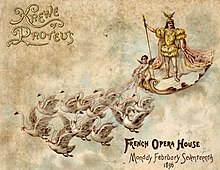


A krewe (/kruː/ KROO) is a social organization that stages parades and/or balls for the Carnival season. The term is best known for its association with Mardi Gras celebrations in New Orleans, but is also used in other Carnival celebrations throughout Louisiana (e.g. in Lafayette, Shreveport, and Baton Rouge) and along the Gulf of Mexico, such as the Gasparilla Pirate Festival in Tampa, Florida, Springtime Tallahassee, and Krewe of Amalee in DeLand, Florida with the Mardi Gras on Mainstreet Parade as well as in La Crosse, Wisconsin and at the Saint Paul Winter Carnival.
The word is thought to have been coined in the early 19th century by a New Orleans–based organization calling themselves Ye Mistick Krewe of Comus, as an archaic affectation; with time, it became the most common term for a New Orleans Carnival organization. The Mistick Krewe of Comus itself was inspired by the Cowbellion de Rakin Society that dated from 1830, a mystic society that organizes annual parades in Mobile, Alabama.
The krewe system then spread from Mobile and New Orleans to other towns and cities with French Catholic heritage, including those with their own Mardi Gras traditions (such as the Courir de Mardi Gras). Following those of New Orleans, Louisiana's next-oldest krewes are mostly based near Lafayette, which crowned its first Rex-style monarch, King Attakapas, in 1897. The state's oldest extant children's krewe, Oberon, is also based in Lafayette, and was founded in 1928.
Today, most Carnival krewes date their origins to the twentieth and twenty-first centuries.
Membership
Krewe members are assessed fees in order to pay for the parade or ball. Fees can range from thousands of dollars a year per person for the most elaborate parades, to as little as $20 a year for smaller clubs. Criteria for krewe membership varies similarly, ranging from exclusive organizations largely limited to relatives of previous members to other organizations open to anyone able to pay the membership fee. Krewes with low membership fees may also require members to work to help build and decorate the parade floats and make their own costumes; higher priced krewes hire professionals to do this work. Parading krewe members are usually responsible for buying their own throws such as beads and coins, which are thrown to parade spectators according to tradition. Some krewes also have other events, such as private dances or parties, for members throughout the year. Some also make a point of supporting charities and good causes.
Some krewes restrict their membership to one sex, while others allow co-ed membership. For example, the Krewe of Endymion from New Orleans and Ye Mystic Krewe of Gasparilla from Tampa are currently restricted to men only. Examples of female-only krewes include the New Orleans' Krewe of Cleopatra and Krewe of Muses and Tampa's Krewe of Venus.
Old line
The first Krewes to parade during Mardi Gras are referred to as "old line krewes". These include the Mistick Krewe, the Krewe of Proteus, Rex, Zulu, Twelfth Night Revelers, and the Knights of Momus.
Super krewe
While there is no official definition for "super Krewe", it is generally accepted that a super krewe possesses over 1000 active dues paying members and maintains at least 500 riders for its parade each carnival.
See also
- Carnival society
- Comparsa
- Krew (disambiguation)
- Crew (disambiguation)
- New Years Associations
- Samba school
- Second line (parades)
References
- "What is La Crosse Mardi Gras?". lacrossemardigras.com.
- "Krewe". Encyclopædia Britannica. Retrieved 2012-06-18.
- "Carnival/Mobile Mardi Gras Timeline". The Museum of Mobile. 2002. Archived from the original on 2004-12-13. (List of events.)
- Dodge, Victoria. "Relive Lafayette's Mardi Gras history as captured in the pages of The Daily Advertiser". The Daily Advertiser. Retrieved 2023-02-07.
- Oberon
- Hardy, Arthur (February 8, 2016). "At 50, Endymion is the largest krewe in New Orleans, but it wasn't always 'super'". The New Orleans Advocate. Retrieved June 29, 2018.
- Winkler-Schmit, David (February 13, 2007). "Mardi Gras Sisterhood: All-female krewes are redefining Carnival -- with a woman's touch". Gambit. Retrieved June 29, 2018.
- Branley, Edward (February 6, 2018). "NOLA History: Women in Carnival". GoNola.com. Retrieved June 29, 2018.
- Guzzo, Paul (January 23, 2017). "Diverse Gasparilla parade has transcended insult of racism". Tampa Bay Times. Retrieved January 14, 2020.
| Parades at Mardi Gras in New Orleans | |
|---|---|
| Old Line Krewes | |
| Super Krewes | |
| Parading Krewes |
|
| Non-Parading Debutantes Krewes |
|
| Streetcar Krewes |
|
| Walking Krewes |
|
| Dancing Krewes |
|
| Disbanded Krewes |
|
| Related | |